

TinkerPop. Home · tinkerpop/blueprints Wiki. Blueprints is a collection of interfaces, implementations, ouplementations, and test suites for the property graph data model.
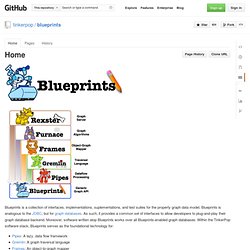
Blueprints is analogous to the JDBC, but for graph databases. Home · tinkerpop/gremlin Wiki. Home · tinkerpop/furnace Wiki. Home · tinkerpop/rexster Wiki. Rexster is a graph server that exposes any Blueprints graph through REST and a binary protocol called RexPro.
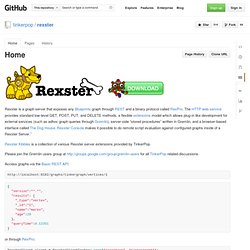
The HTTP web service provides standard low-level GET, POST, PUT, and DELETE methods, a flexible extensions model which allows plug-in like development for external services (such as adhoc graph queries through Gremlin), server-side “stored procedures” written in Gremlin, and a browser-based interface called The Dog House. Rexster Console makes it possible to do remote script evaluation against configured graphs inside of a Rexster Server.1 Rexster Kibbles is a collection of various Rexster server extensions provided by TinkerPop. Please join the Gremlin users group at for all TinkerPop related discussions. Access graphs via the Basic REST API: or through RexPro: RexsterClient client = RexsterClientFactory.open("localhost", "tinkergraph");List<Map<String, Object>> results = client.execute("g.v(1).map"); Non-Maven users can get the raw release jars from Apache’s Central Repository.
Home · tinkerpop/frames Wiki. Home · tinkerpop/pipes Wiki. Pipes is a dataflow framework using process graphs.

A process graph is composed of Pipe vertices connected by communication edges. A Pipe implements a simple computational step that can be composed with other Pipe objects to create a larger computation. Such data flow graphs allow for the splitting, merging, looping, and in general, the transformation of data from input to output. There are numerous Pipe classes that come with the main Pipes distribution. Once a good understanding of each Pipe accomplished, then using the framework is straightforward. Node.js. NoSQL. "Structured storage" redirects here.

For the Microsoft technology also known as structured storage, see COM Structured Storage. Orient Technologies - Open source solutions built around the Orient DB. Twitter/gizzard. Memcached - a distributed memory object caching system. Leading Enterprise Java Web Framework. Stack: Overview. Get Started Now With Typesafe Activator What is a Reactive application?
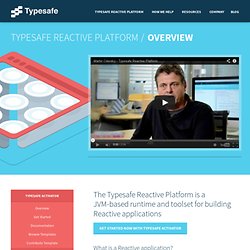
Reactive applications are a new class of applications that are becoming more and more prevalent in both Consumer and Enterprise-facing environments. Reactive applications are fundamentally different to the traditional web-based or mobile applications seen today and are distinguished by having one or more of the following defining traits: Event-Driven: Enables parallel, asynchronous processing of messages or events with ease.
Scalable: Can scale within and across nodes elastically to provide compute power on-demand when it’s needed. Resilient: The ability to recover and repair itself automatically in order to provide seamless business continuity. The Scala Programming Language. Products: Console. Download Typesafe Activator A new addition to the Typesafe Reactive Platform is Typesafe Activator, a unique, browser-based tool that helps developers get started with Typesafe technologies quickly and easily.

Activator is a hub for developers wanting to build Reactive applications. Unlike previous developer-focused offerings that are delivered simply via a website, Activator breaks new ground by delivering a rich application directly to the desktop. Simple build tool. Home.
Akka. JavaScript. JavaScript is classified as a prototype-based scripting language with dynamic typing and first-class functions.
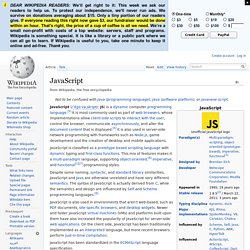
This mix of features makes it a multi-paradigm language, supporting object-oriented,[6] imperative, and functional[1][7] programming styles. JavaScript has been standardized in the ECMAScript language specification. History[edit] Beginnings at Netscape[edit] JavaScript was originally developed by Brendan Eich, while working for Netscape Communications Corporation. Although it was developed under the name Mocha, the language was officially called LiveScript when it first shipped in beta releases of Netscape Navigator 2.0 in September 1995, but it was renamed JavaScript[10] when it was deployed in the Netscape browser version 2.0B3.[11] The change of name from LiveScript to JavaScript roughly coincided with Netscape adding support for Java technology in its Netscape Navigator web browser. jQuery: The Write Less, Do More, JavaScript Library. jQuery lightbox for images, videos, YouTube, iframes, ajax. jQuery Masonry.
Zoomooz.js. Zoomooz is: 6KB gzipped and 18KB minified.

This includes everything but jQuery. Make any web page zoom. Latest version: 1.1.9 (Nov 11, 2013, hacky fix for the back and forward buttons #66) The Ultimate jQuery List. Cascading Style Sheets. CSS is designed primarily to enable the separation of document content from document presentation, including elements such as the layout, colors, and fonts.[1] This separation can improve content accessibility, provide more flexibility and control in the specification of presentation characteristics, enable multiple pages to share formatting, and reduce complexity and repetition in the structural content (such as by allowing for tableless web design).
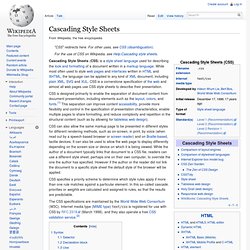
CSS can also allow the same markup page to be presented in different styles for different rendering methods, such as on-screen, in print, by voice (when read out by a speech-based browser or screen reader) and on Braille-based, tactile devices. It can also be used to allow the web page to display differently depending on the screen size or device on which it is being viewed.
CSS specifies a priority scheme to determine which style rules apply if more than one rule matches against a particular element. Syntax[edit] 960 Grid System. Spend your time innovating, not replicating. HTML5. HTML5 is a markup language used for structuring and presenting content for the World Wide Web and a core technology of the Internet. It is the fifth revision of the HTML standard (created in 1990 and standardized as HTML 4 as of 1997)[2] and, as of December 2012[update], is a candidate recommendation of the World Wide Web Consortium (W3C).[3] Its core aims have been to improve the language with support for the latest multimedia while keeping it easily readable by humans and consistently understood by computers and devices (web browsers, parsers, etc.). HTML5 is intended to subsume not only HTML 4, but also XHTML 1 and DOM Level 2 HTML.[2] History[edit] The Web Hypertext Application Technology Working Group (WHATWG) began work on the new standard in 2004.
At that time, HTML 4.01 had not been updated since 2000,[8] and the World Wide Web Consortium (W3C) was focusing future developments on XHTML 2.0. While HTML5 is often compared to Flash, the two technologies are very different. Promoting and Supporting High-Resolution Images & Zoomable User Interfaces (ZUIs) on the Web. W3Schools Online Web Tutorials. JavaScript Tutorial.